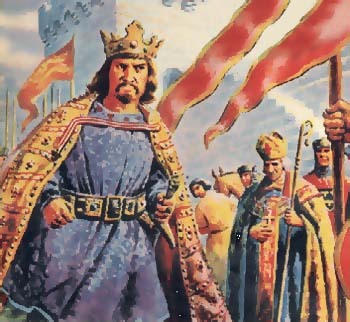The Epic of Old English – Part 2
(Click here for Part 1)
In 1066, the Battle of Hastings ensued. It was a war between the Duke of Normandy and the people of England. William II, otherwise known as William the Conqueror, wanted to become King of England in order to add to his royal titles. He won the final battle at Hastings, and became the King of England while still maintaining his title as Duke of Normandy. After he conquered England, he brought his Norman-French family and friends to England and established an aristocracy. With it, he brought Old Norman French, Old English’s new enemy. The two languages did not start out as friends nor would they ever be friends. But Old Norman French forced herself into Old English’s territory and found a way to be number one. Through the next three to four centuries, an English-Norman French royal line was established and with it, a new prestigious language, Old Norman French.
The royal family prospered as they maintained a hold of Normandy and England and continued to conquer surrounding areas such as Wales and Ireland. Old Norman French was the language spoken by less people in comparison to Old English. However, because the aristocracy was largely Norman French, they dictated which language was more important and prestigious. All the peasants were Anglo-Saxon and therefore spoke Old English, but their status was slowly being diminished. In order to communicate, the Norman French had to learn some Old English, and vice versa. Words of government and law such as royal, state, jury, and judge were introduced.
In the 12th century, King John, the youngest son of King Henry II, ascended to the throne as King of England and Duke of Normandy. He was the only surviving offspring of his parents. But there were still other branches of his extended family that claimed they should have the throne. Having two titles over two different parts of Europe also added to the confusion of who was to ascend the throne. When King John won, his cousin, Arthur, decided to wage war against him for taking the throne. Through a series of battles and wars, King John lost all the land he possessed in Normandy as well as his title. As a result, he was called King John Lackland because of his lack of land. Adding insult to injury, King John shamelessly had affairs with other noblewomen enraging their husbands. With strained relations between the Norman French and English, a clear separation of the two areas was forming. Additionally, in 1244, it became illegal to own land in both England and France. The Anglo-Saxons were beginning to take pride in their language and thus began growth of Old English into Middle English.
Despite the condescension that was placed upon Old English by Old Norman French, Old English made it out of the wars and struggles alive, but in a new and reinvented way. Middle English was her new name and it was starkly different from Old English. She had fewer case endings for nouns and adjectives and new demonstratives such as this/that. Endings for verbs were simplified so that there were fewer to use. Because of the loss of endings, prepositions, demonstratives, and articles came about and were grammaticized into the language. As a result, word order began to play a role in the grammar of Middle English. In the place of subjunctives, modals such as would and could were being used. The use of double negatives became more prominent and was widely accepted. And now that the Anglo-Saxons and Norman-French were separated, English was encouraged for use in parliament and all areas of government. In fact, the king himself, King Henry III, encouraged the use of Middle English.
In 1476, the printing press was invented creating an avenue for Middle English to be thrust into the spotlight. Writers such as Chaucer could have their literature published further fostering the growth of Middle English and building prestige. By 1500, the most radical morphological and syntactic changes were essentially over and thus began a new era, and a new name, Modern English. Stay tuned for next month’s final installment of The Epic of English – Part 3!
About Language Connections:
Language Connections is one of the top language service companies in the US. Over the last 30 years, we’ve focused on providing the best business translation services, interpreting services, as well as interpreter training and customized language training programs. In addition to top-tier corporate language training, we offer certified corporate interpreters and professional business translation services in 200+ languages. Our network includes linguists with backgrounds in all major industries. They’re ready to meet your needs, whether they’re for technical translation services, legal translation, government translation services, international development translation services, education translation services, life sciences translation, or something else. Reach out to us today for a free quote on our cost-efficient and timely translation services, interpreters, or other linguistic services.
Language Connections Inc.
2001 Beacon Street, Suite 105,
Boston, MA 02135
Phone: +1-617-731-3510
Email: service@languageconnections.com



